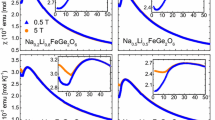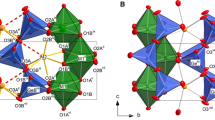Abstract
CoGeO3 was synthesized at 1,273 and 1,448 K using ceramic sintering techniques in the monoclinic and orthorhombic modification, respectively. The two compounds were analysed by magnetic susceptibility measurements and neutron diffraction in order to study magnetic ordering and spin structures at low temperature. The monoclinic form of CoGeO3 has C2/c symmetry and orders magnetically below 36 K with a small negative paramagnetic Curie temperature θ P = −4.6 (2) K. The magnetic structure can be described with k = (1, 0, 0) in the magnetic space group C2′/c′ having a ferromagnetic spin arrangement within the chains of M1 sites, but a dominating antiferromagnetic coupling between the chains. At the M1 sites the magnetic spins are aligned within the a–c plane forming an angle of 120° with the +a-axis and they are not parallel to the spins at M2. Here spins are also ferromagnetically coupled within, but antiferromagnetically coupled between the M1/M2 site bands. The orthorhombic phase of CoGeO3 displays Pbca symmetry and transforms to an antiferromagnetically ordered state [θ P = −18.6(2) K] below 33 K. The magnetic spin structure can be described with k = (0, 0, 0) in space group Pbca′ and it is similar to the one of the C2/c phase except that it is non-collinear in nature, i.e. there are components of the magnetic moment along all three crystallographic axes. Small magneto-elastic coupling is observed in the orthorhombic phase.













Similar content being viewed by others
Notes
The neutron diffraction pattern of Wiedenmann et al. (1986) probably was taken with λ ≈ 1.24 Å instead of 2.48 Å given in the text. With the later wavelength the Bragg peaks displayed in the Figure at higher angles would not be accessible.
References
Akimoto S-I, Katsura T, Syono Y, Fujisawa H, Komada E (1965) Polymorphic transition of pyroxenes FeSiO3 and CoSiO3 at high pressures and temperatures. J Geophys Res 70(29):5269–5278
Becker UW, Felsche J (1987) Phases and structural relations of the rare earth germanates RE2Ge2O7, RE = La–Lu. J Less Common Metals 128:269–280
Bertaut EF (1968) Representation analysis of magnetic structures. Acta Crystallogr A24:217–231
Blundell SJ, Steer CA, Pratt FL, Marshall IM, Hayes W, Ward RCC (2003) Detection of magnetic order in the S = 1 chain compound LiVGe2O6 using implanted spin-polarized muons. Phys Rev B67:224411 (4 pages)
Cagliotti G, Paoletti A, Ricci FP (1958) Choice of collimators for a crystal spectrometer for neutron diffraction. Nucl Instrum 3:223–228
Cámara F, Nestola F, Angel RJ, Ohasi H (2009) Spontaneous strain variation through the low-temperature displacive phase transition in LiGaSi2O6. Eur J Mineral 21:599–614
Cameron M, Papike JJ (1981) Structural and chemical variations in pyroxenes. Am Mineral 66:1–50
Fang JA, Townes WD (1969) The crystal structure of manganese metagermanate, MnGeO3. Z Krist 130:139–147
Fei Y (1995) Thermal expansion. In: Ahrens TJ (ed) Mineral physics and crystallography: a handbook of physical constants. Am Geophys Union, pp 29–44
Goodenough JB (1963) Magnetism and the chemical bond. Wiley Interscience, New York
Greenblatt M, Hornreich RM, Sharon B (1974) Evidence for a spin-reorientation type phase transition in FeGeO3. Solid State Comm 14:1177–1181
Grodzicki M, Redhammer GJ, Reissner M, Steiner W, Amthauer G (2009) Electronic and magnetic structure of pyroxenes I. Hedenbergite. Phys Chem Min 36 (http://dx.doi.org/10.1007/s00269-009-0306-2)
Gurewitz E, Shaked H (1972) Classification of magnetic structures in some orthorhombic space groups. Acta Crystallogr A28:280–284
Herpin P, Whuler A, Boncher B, Sougi M (1971) Étude cristallographique et magnétique de MnGeO3. Phys Stat Sol B 44:71–84
Hugh-Jones D (1997) Thermal expansion of MgSiO3 and FeSiO3 ortho- and clinopyroxenes. Am Mineral 82:689–696
Hugh-Jones DA, Angel RJ (1997) Effect of Ca2+ and Fe2+ on the equation of state of MgSiO3 orthopyroxene. J Geophys Res 102:12333–12340
Hugh-Jones DA, Woodland AB, Angel RJ (1994) The structure of high pressure C2/c ferrosilite and crystal chemistry of high pressure C2/c pyroxenes. Am Mineral 79:1032–1041
Jodlauk S, Becker P, Mydosh JA, Khomskii DI, Lorenz T, Streltsov SV, Hezel DC, Bohaty L (2007) Pyoxenes: a new class of multiferroics. J Phys Cond Matters 19(43):432201
Knight KS (1996) A neutron powder diffraction determination of the thermal expansion tensor of crocoite (PbCrO4) between 60 K and 290 K. Mineral Mag 60:963–972
Knight KS, Stretton IC, Schonfield PF (1999) Temperature evolution between 50 K and 320 K of the thermal expansion tensor of gypsum derived from neutron powder diffraction data. Phys Chem Min 26:477–483
Litvin DB (2008) Tables of crystallographic properties of magnetic space groups. Acta Crystallogr A64:419–424
Lueken H (1999) Magnetochemie. Eine Einführung in Theorie und Praxis. Teubner Studienbücher, Chemie. Teubner Verlag, Stuttgart, pp 509
Nestola F, Gatta DG, Boffa Ballaran T (2006) The effect of Ca substitution on the elastic and structural behaviour of orthoenstatite. Am Mineral 91:809–815
Nestola F, Redhammer GJ, Pamato MG, Secco L, Dal Negro A (2009) High-pressure phase transformation in LiFeGe2O6 pyroxene. Am Mineral 94:616–621
Ohashi Y, Burnham CW (1973) Clinopyroxene lattice deformation: the roles of chemical substitution and temperature. Am Mineral 58:843–849
Ozima M (1983) Structure of orthopyroxene-type and clinopyroxene-type magnesium germanium oxide MgGeO3. Acta Crystallogr C39:1169–1172
Peacor D (1968) The crystal structure of CoGeO3. Z Krist 126:299–306
Redhammer GJ, Roth G (2004) Structural changes upon the temperature dependent C2/c → P21/c phase transition in LiMe3+Si2O6 clinopyroxenes, Me = Cr, Ga, Fe, V and Sc. Z Krist 219(10):585–605
Redhammer GJ, Roth G, Paulus W, André G, Lottermoser W, Amthauer G, Treutmann W, Koppelhuber-Bitschnau B (2001) Crystal and magnetic structure of Li-Aegirine LiFe3+Si2O6: a temperature dependent study. Phys Chem Min 28:337–346
Redhammer GJ, Roth G, Treutmann W, Paulus W, André G, Pietzonka C, Amthauer G (2008) Magnetic ordering and spin structure in Ca-bearing clinopyroxenes CaM2+(Si, Ge)2O6, M = Fe, Ni, Co, Mn. J Solid State Chem 181:3163–3176
Redhammer GJ, Roth G, Treutmann W, Hoelzel M, Paulus W, André G, Pietzonka C, Amthauer G (2009a) The magnetic structure of clinopyroxene-type LiFeGe2O6 and revised data on multiferroic LiFeSi2O6. J Solid State Chem 182:2374–2384
Redhammer GJ, Pachler A, Hoelzel M, Tippelt G, Roth G, Amthauer G (2009b) Nuclear and magnetic structure of NaFeGe2O6 in comparison to NaFeSi2O6 (aegirine) (in prep)
Rodríguez-Carvajal J (2001) Recent developments of the program. In: Commission on powder diffraction (IUCr). Newsletter 26:12–19. Available at http://journals.iucr.org/iucr-top/comm/cpd/Newsletters/
Sasaki S, Takéuchi Y (1982) Electron-density distribution of three orthopyroxenes, Mg2Si2O6, Co2Si2O6, and Fe2Si2O6. Z Krist 158:279–297
Sawaoka A, Miyahara S (1964) Magnetic properties of some synthetic pyroxenes. J Phys Soc Jpn 19:1254
Sawaoka A, Miyahara S, Akimoto SI (1968) Magnetic properties of several metasilicates and metagermanates with pyroxene structure. J Phys Soc Jpn 25:1253–1257
Schlenker JL, Gibbs GV, Boisen MB Jr (1975) Thermal expansion coefficients for monoclinic crystals: a phenomenological approach. Am Mineral 60:828–833
Schonfield PF, Knight KS, van der Houwen JAM, Valsami-Jones E (2004) The role of hydrogen bonding in the thermal expansion and dehydration of brushite, di-calcium phosphate dihydrate. Phys Chem Min 31:606–624
Shamir N, Shaked H (1975) The magnetic structure of CoGeO3. Phys Stat Sol (a) 30:315–322
Streltsov SV, Khomskii DI (2008) Electronic structure and magnetic properties of pyroxenes (Li,Na)TM(Si,Ge)2O6: low-dimensional magnets with 90° bonds. Phys Rev B77:064405 (11 p)
Tauber A, Kohn JA (1965) Orthopyroxene and clinopyroxene polymorphs of CoGeO3. Am Mineral 50:13–21
Thompson JB (1970) Geometrical possibilities for amphibole structures: model biopyriboles. Am Mineral 55:292–293
Wiedenmann A, Regnard J-R, Fillion G, Hafner SS (1986) Magnetic properties and magnetic ordering of the orthopyroxenes FexMg1–xSiO3. J Phys C Solid State Phys 19:3683–3695
Wildner M (1992) On the geometry of Co(II)O6 polyhedra in inorganic compounds. Z Krist 202:51–70
Yamanaka T, Hirano M, Takéuchi Y (1985) A high temperature transition in MgGeO3 from clinopyroxene (C2/c) type to orthopyroxene (Pbca) type. Am Mineral 70:365–374
Acknowledgments
This work was supported by the Fonds zur Förderung der wissenschaftlichen Forschung, FWF, Vienna, under grants number R33-N10 and P19762/N10. Neutron diffraction experiments have been supported by the European Commission under the 7th Framework Programme through the “Research Infrastructures” action of the “Capacities” Programme, Contract No: CP_CSA_Infra-2008-1.1.1 Number 226507-NIMI3. Fernando Cámara and Fabrizio Nestola are thanked for their careful and helpful reviews of the manuscript.
Author information
Authors and Affiliations
Corresponding author
Electronic supplementary material
The 53 supplementary CIF files are unfortunately not in the Publisher's archive anymore.
Rights and permissions
About this article
Cite this article
Redhammer, G.J., Senyshyn, A., Tippelt, G. et al. Magnetic and nuclear structure and thermal expansion of orthorhombic and monoclinic polymorphs of CoGeO3 pyroxene. Phys Chem Minerals 37, 311–332 (2010). https://doi.org/10.1007/s00269-009-0335-x
Received:
Accepted:
Published:
Issue Date:
DOI: https://doi.org/10.1007/s00269-009-0335-x




